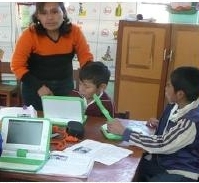The little town of Arahuay, Peru must feel like a ugly duckling suddenly becoming a beautiful swan - one day it was a Peruvian backwater and the next it's the center of global technology attention with a OLPC Peru pilot in its midst..
First there was Carla Gomez Monroy's detailed write up of her experience at Institución Educativa Apóstol Santiago in Arahuay. Then the AP wrote a sweet Christmas story on how OLPC was inspiring children:
"Some tell me that they don't want to be like their parents, working in the fields," first-grade teacher Erica Velasco says of her pupils. She had just sent them to the Internet to seek out photos of invertebrates -- animals without backbones.After a near-death experience at the school, Ivan Krstić let us know he was astounded in Arahuay with the impact that One Laptop Per Child has on the entire community - children, parents, teachers, and school administrators. He found three key changes brought by the technology."What they work with most is the (built-in) camera. They love to record," says Maria Antonieta Mendoza, an Education Ministry psychologist studying the Arahuay pilot to devise strategies for the big rollout when the new school year begins in March.
First, children started communicating more in and out of class, using the XO as a means to eclipse physical barriers and as a way to break down social barriers. Then, since each child had the exact same laptop, they started to share ideas instead of being selfish with things. Last, but not least, there was a change in family perception of school:
"Children’s fathers used to seethe with fury when the laptops were passed out, because the kids no longer wanted to help work in the field all day," he continued.I think the MIT Review captures the current OLPC Peru feelings with its apt article title, "OLPC's Peruvian Honeymoon". While the title referred to Mary Lou Jepsen's belated honeymoon with her husband in Peru, it is apropos to this stage of OLPC Peru development."I didn’t know how we’d stop the fathers from revolting and making the kids return their XOs," he says, shaking his head slightly. "The kids solved the dilemma for me: they taught their fathers how to use the Internet and a search engine."
"Then they started showing them the work they were doing for school. The reports they wrote, the pictures they took, the notes they compiled. And the fathers had actual proof that their kids were learning," he concluded.
So far, we've been awed by the picturesque pilot progress and very shortly there will be 240,000 XO laptops headed towards Peru as One laptop Per Child ramps up its largest deployment ever attempted. Now OLPC is in a mad dash to refine its deployment approach, and just completed its first deployment guide:
With input from the Tech Team, the Learning Team, Brightstar, and the Deployment Team, we now have a Deployment Guide. The guide covers planning, execution, and support, along with some tips based upon our experience in trial deployments around the world; a sample deployment schedule; a sample workshop schedule; a check list to guide you through the deployment process; and a glossary of OLPC terms.Here's to wishing all the OLPC teams luck in implementation, the hardest, messiest, and most time and resource intensive aspect of any technology project, exponentially compounded by each distance, language, and culture barrier. Or as MIT Review says:
[Mary Lou] Jepsen acknowledged that the challenges Peru faces in reforming its educational system dwarf those of actually designing the pint-sized green-and-white gadgets. "Laptops are easy; education is hard to transform," she told ministry staff..





can we have a link to the deployment guide, please?
Thanks
What a grand request, Yama. I was thinking of asking for the deployment guide myself in the post, but I refrained. I figured it was enough for OLPC to recognize the need and put one together. Of course it would be best if it were publicly available so that people or countries interested in an XO deployment could see what's required.
@wayan
"Of course it would be best if it were publicly available so that people or countries interested in an XO deployment could see what's required."
That's crazy talk!
@ Patrick and Yama,
If you were on the ball you'd realize Wayan does not have a link to a 'Deployment Guide' but in fact only mentions the quote from Walter Bender in his weekly news update.
Walter apparently has the 'Deployment Guide' somewhere and has not yet shared it with us.
I'm sure it will appear when it is finally ready.
"First there was Carla Gomez Monroy's detailed write up of her experience at Institución Educativa Apóstol Santiago in Arahuay."
http://wiki.laptop.org/go/OLPC_Peru/Arahuay
I read the write up. It has enough information to write a book about it.
My first impressions:
1 It is eerie to see how well Sugar and the activities are received by the children, and teachers.
I have known for ages that the desktop metaphor is bad outside the office. Still it is unsettling to see my feelings were so right. The designer of Sugar are eligible for some (virtual) statues. I think especially the fact there are no "files" and "directories/folders" to mess with, helps the children and teachers get to grips with the XO.
2 The children help each other and the teachers, as predicted.
3 The children will use the XO wherever they are, especially at home.
4 Teachers will gradually adapt the curriculum to the XOs
5 Uruguay has a Constructionist Curriculum. A nice link to throw at the next complaint about the inclusion of "unsupported" Constructionism.
6 The teachers stay in control.
7 I am missing reports about the collaboration features. It would be really nice to see how the children use the collaboration and other things like IM and email. If they use them at all.
8 I am still looking for one of the doomsday predictions about the failure of the XO to show up. There was teacher "anxiety" here, as predicted, but that could be solved. The machines seem to function more or less adequately, just as the software.
Winter
about the famous deployment notes, I am afraid it might be a work in progress, about which I am acquainted by another source. What I saw like 5 days ago doesn't look like a mission accomplished, thus I was curious if there was another document which I had not seen, to which Bender refers to. What I saw shows good, honest work is being put on it and I wish the best to those working in that task. And yes, do please share when it's put together.
@ Winter
>Uruguay has a Constructionist Curriculum
Hi Winter, I'm curious about this assertion of yours. Could you give us more information, please? You mention a link.
You also said in a comment to another article a few days ago that it cannot be said that constructionism has never been successful by the fact that no one had done it right yet. Would you say that Uruguay's it, and that it would prove constructionism does work?
I do know hard working Uruguayan teachers, and respect their way of doing things, which IMHO is not constructionism. With all respect, I do not believe that the Uruguayan educational system can ever, ever become constructivist/ionist, mostly because of one of its main strengths, which is its stability. No matter what they say in their official curriculum. I have set my opinion on this matter in detail in a book I published in the late '90s. While things can change, my little notes prove (or so I believe :-) why we shouldn't hold our breaths in this matter. You'll also find some of my opinions on Education, which of course I have polished some since
http://netoso.com/brevesapuntesv0_9.rtf
@Yama Ploskonka:
"Hi Winter, I'm curious about this assertion of yours. Could you give us more information, please? You mention a link."
I found this in the link:
"It is important to point out that the Peru Educational Curricula [1] are based on a Constructionist Methodology. Teachers definitely work much more constructively than in many other countries. The work is more focused on developing individual capacities and integrating all the different areas. We still have to consider some exceptions."
[1] http://destp.minedu.gob.pe/secundaria/nwdes/pdfs/disenocurricularnacional.pdf
I was just quoting that, with no extra knowledge.
@Yama Ploskonka:
"Would you say that Uruguay's it, and that it would prove constructionism does work?"
No. The most important reason being that I have no idea at all about Uruguay education.
But for another, because there has never been a sensible definition of constructionism that can be tested in one way or another. What I do believe is that many of the ideas behind constructionism can and have been tested. Especially things like peer education and group project work.
Winter
@ Winter
sorry about asking about 'guay. In your previous comment, number 5 must have been a typo. Thanks
@Yama Ploskonka"
"With all respect, I do not believe that the Uruguayan educational system can ever, ever become constructivist/ionist, mostly because of one of its main strengths, which is its stability. No matter what they say in their official curriculum. I have set my opinion on this matter in detail in a book I published in the late '90s. While things can change, my little notes prove (or so I believe :-) why we shouldn't hold our breaths in this matter. You'll also find some of my opinions on Education, which of course I have polished some since
http://netoso.com/brevesapuntesv0_9.rtf"
Given that I have never set foot in South America (nor speak Spanish), I would never try to contradict someone who has actually been there and studied it. So if you say so, I will accept it without even questioning it.
Winter
@Yama Ploskonka:
"sorry about asking about 'guay. In your previous comment, number 5 must have been a typo."
See, I am even mixing up countries. My bad. I hope my colleges from S America won't hear about it.
Winter